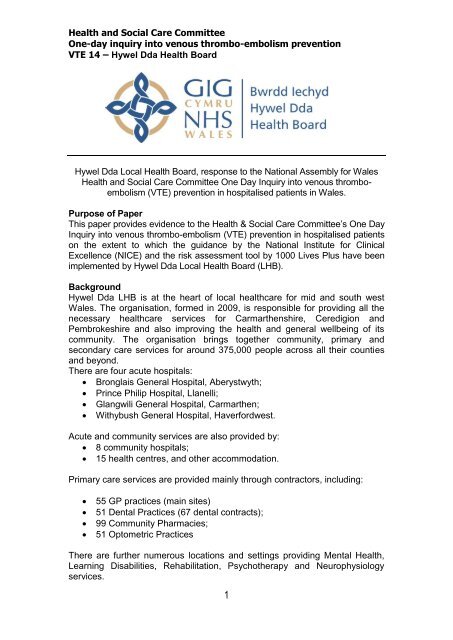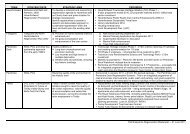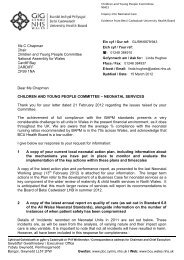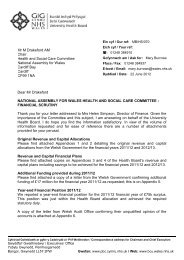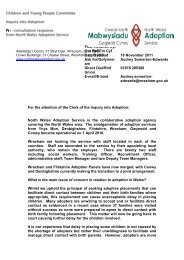Consultation response: VTE 14 - Hywel Dda Health Board PDF 266 ...
Consultation response: VTE 14 - Hywel Dda Health Board PDF 266 ...
Consultation response: VTE 14 - Hywel Dda Health Board PDF 266 ...
- No tags were found...
Create successful ePaper yourself
Turn your PDF publications into a flip-book with our unique Google optimized e-Paper software.
<strong>Health</strong> and Social Care CommitteeOne-day inquiry into venous thrombo-embolism prevention<strong>VTE</strong> <strong>14</strong> – <strong>Hywel</strong> <strong>Dda</strong> <strong>Health</strong> <strong>Board</strong><strong>Hywel</strong> <strong>Dda</strong> Local <strong>Health</strong> <strong>Board</strong>, <strong>response</strong> to the National Assembly for Wales<strong>Health</strong> and Social Care Committee One Day Inquiry into venous thromboembolism(<strong>VTE</strong>) prevention in hospitalised patients in Wales.Purpose of PaperThis paper provides evidence to the <strong>Health</strong> & Social Care Committee’s One DayInquiry into venous thrombo-embolism (<strong>VTE</strong>) prevention in hospitalised patientson the extent to which the guidance by the National Institute for ClinicalExcellence (NICE) and the risk assessment tool by 1000 Lives Plus have beenimplemented by <strong>Hywel</strong> <strong>Dda</strong> Local <strong>Health</strong> <strong>Board</strong> (LHB).Background<strong>Hywel</strong> <strong>Dda</strong> LHB is at the heart of local healthcare for mid and south westWales. The organisation, formed in 2009, is responsible for providing all thenecessary healthcare services for Carmarthenshire, Ceredigion andPembrokeshire and also improving the health and general wellbeing of itscommunity. The organisation brings together community, primary andsecondary care services for around 375,000 people across all their countiesand beyond.There are four acute hospitals: Bronglais General Hospital, Aberystwyth; Prince Philip Hospital, Llanelli; Glangwili General Hospital, Carmarthen; Withybush General Hospital, Haverfordwest.Acute and community services are also provided by: 8 community hospitals; 15 health centres, and other accommodation.Primary care services are provided mainly through contractors, including:55 GP practices (main sites)51 Dental Practices (67 dental contracts);99 Community Pharmacies;51 Optometric PracticesThere are further numerous locations and settings providing Mental <strong>Health</strong>,Learning Disabilities, Rehabilitation, Psychotherapy and Neurophysiologyservices.1
<strong>Health</strong> and Social Care CommitteeOne-day inquiry into venous thrombo-embolism prevention<strong>VTE</strong> <strong>14</strong> – <strong>Hywel</strong> <strong>Dda</strong> <strong>Health</strong> <strong>Board</strong>IntroductionAny <strong>VTE</strong> occurring within 90 days of a hospital admission is classed as ahospital-acquired <strong>VTE</strong>.Hospital-acquired <strong>VTE</strong>, ranging from asymptomatic deep vein thrombosis (DVT)to massive pulmonary embolism (PE), is common during and after hospitaladmission and is considered a significant cause of morbidity and mortality inhospitalized patients. There could be an estimated 60,000 deaths due topulmonary embolism (PE) in the UK, although the Office for National Statisticsfor England records the recognised figure on death certificates in 2010 as 6,000.It is recognised that death due to PE is under diagnosed and that for every casewhere PE is stated as a cause of death in hospital, there are usually another twopatients where the diagnosis was missed. There were 284,000 hospital deathsin England and Wales in 2007, and the VITAE European study estimated that12% of these deaths were due to PE. However post-mortem studies describe afalling incidence from around 10% of hospital deaths around 1980 to around 2%in more recent studies. Of course the use of primary thromboprophylaxis willhave impacted on this decline, change in practice means patients mobilisequickly and will be sent home earlier, and that most PE deaths will occur afterdischarge.It is estimated that two thirds of PE are hospital-acquired and that 70% of deathsoccur in medical rather than surgical patients. The risk of <strong>VTE</strong> in medicaladmissions varies from 15% in general medical patients to 50% in strokepatients, while clinically recognised PE occurs in 1% of general medical patients.It is also recognised that the risk of <strong>VTE</strong> exists for up to 90 days after admission,and that many <strong>VTE</strong> occur post discharge. Furthermore <strong>VTE</strong> is often clinicallysilent, for 80% of DVT have no clinical signs and yet can result in long termsequelae of the post thrombotic syndrome.Implementation of NICE guidancePolicies and protocols for the prevention of venous thrombo-embolism in bothsurgical and medical in-patients, were in place in the constituent NHS Trustsof the <strong>Hywel</strong> <strong>Dda</strong> LHB, for a number of years prior to the publication of theNICE guidance.2
<strong>Health</strong> and Social Care CommitteeOne-day inquiry into venous thrombo-embolism prevention<strong>VTE</strong> <strong>14</strong> – <strong>Hywel</strong> <strong>Dda</strong> <strong>Health</strong> <strong>Board</strong>In April 2007, NICE published Clinical Guideline (CG) 46 ‘Reducing the risk ofvenous thrombo-embolism in in-patients undergoing surgery’. This guidancewas updated and replaced in January 2010 by CG92 ‘Reducing the risk ofvenous thrombo-embolism (deep vein thrombosis and pulmonary embolism)in patients admitted to hospital.Following the publication of CG 46, an audit programme was initiated tomonitor and facilitate its implementation within the surgical specialties.In July 2009, the <strong>Hywel</strong> <strong>Dda</strong> Thrombosis Committee (which reports to theMedicine Management Group) held its inaugural meeting. The overall purposeof the Thrombosis Committee is ‘to develop and oversee the implementationof guidelines for prevention and management of thrombo-embolism across<strong>Hywel</strong> <strong>Dda</strong> Local <strong>Health</strong> <strong>Board</strong>’.In December 2009, the All Wales Thrombosis Group launched the All WalesThromboprophylaxis Risk Assessment Tool which following review andinclusion of a limited number of drug options by the <strong>Hywel</strong> <strong>Dda</strong> ThrombosisCommittee was adopted within <strong>Hywel</strong> <strong>Dda</strong> LHB, initially within surgical preassessmentclinics. However, further discussion across <strong>Hywel</strong> <strong>Dda</strong> LHB wasrequired to move towards a consistent approach in the product prescribed forlow molecular weight Heparin and this was referred to the MedicineManagement Group. This delayed the roll out of the All WalesThromboprophylaxis Risk Assessment tools across all relevant specialties.An Audit undertaken in Prince Philip Hospital (PPH) in 2005 identified thatapproximately 40% of patients received prophylaxis. And a further audit in2010 identified that approximately 46% of patients received prophylaxis.Implementation of the 1000 Lives Plus <strong>VTE</strong> Risk Assessment ToolsFollowing the launch of the 1000 Lives Plus Programme area ‘Reducing Harmfrom Hospital Acquired Thrombosis’ (HAT) in May 2010, the implementationof HAT became an organizational priority for <strong>Hywel</strong> <strong>Dda</strong> LHB asdemonstrated by the appointment of an executive lead for HAT. In order toprogress the HAT collaborative a <strong>Hywel</strong> <strong>Dda</strong> HAT Implementation Group wasestablished which enabled a more focused approach to progressing thevarious elements in support of the successful implementation of HAT acrossthe 4 District Hospitals, within all specialties.<strong>VTE</strong> Risk Assessment Tool: the <strong>VTE</strong> Risk Assessment Forms were‘localised’ for use across <strong>Hywel</strong> <strong>Dda</strong> LHB, including achievement of consistentapproach to the prescribing of low molecular weight Heparin, thereforeharmonizing practice across <strong>Hywel</strong> <strong>Dda</strong> LHB.3
<strong>Health</strong> and Social Care CommitteeOne-day inquiry into venous thrombo-embolism prevention<strong>VTE</strong> <strong>14</strong> – <strong>Hywel</strong> <strong>Dda</strong> <strong>Health</strong> <strong>Board</strong>Launch of 1000 Lives Plus HATOn the 17 th October 2011 following awareness raising through a variety ofmeans such as letter by Medical Director, notification via Global Email,introduction at Grand Round, the <strong>VTE</strong> Risk Assessment forms were launchedin the acute hospitals for all specialties.AuditSee Effectiveness & utilisation of pharmacological & Mechanical prophylaxis for<strong>VTE</strong>.Given the progress made, the <strong>Hywel</strong> <strong>Dda</strong> HAT Implementation Group has nowbeen disbanded to be replaced by 4 hospital based HAT ImplementationGroups, which will engender greater local ownership of the continuedimplementation of HAT across the 4 District Hospitals. These 4 Hospital HATImplementation Groups will report directly to the County Quality & SafetyCommittees in line with the other 1000 Lives Plus Collaboratives as well as tothe <strong>Hywel</strong> <strong>Dda</strong> Thrombosis Committee.The <strong>Hywel</strong> <strong>Dda</strong> Thrombosis Committee fulfils the role of HAT Steering Groupand will support the implementation of HAT within each of the District Hospitalsby addressing organisation wide issues such as development of ThrombosisPolicy, education of medical staff, monitoring/performance managementincluding the development of process for the calculation of a reliable VTR rateand management operational systems, patient information leaflets and futurespread of HAT prevention into the Community Hospitals.Thrombosis PolicyAll thrombosis related guidance, protocols, and policies currently in placewithin <strong>Hywel</strong> <strong>Dda</strong> LHB have been collated and reviewed by the <strong>Hywel</strong> <strong>Dda</strong>Thrombosis Committee. An overarching Thrombosis Policy will be draftedwhich will ‘house’ all the relevant guidance, protocols, policies.An Anti-Embolic Stocking (AES) Policy has been approved which ensures aconsistent approach to the care of all patients admitted to hospital that havebeen prescribed AES and in line with the 1000 Lives Plus HAT Programme.Education of Medical Staff:Clinical Leads and Consultant Haematologists in each area have providededucation to clinicians on the introduction and completion of the <strong>VTE</strong> RiskAssessment forms. In addition, they have also attended Senior Nurse Meetingsand met with Anaesthetic and Orthopaedic Teams to promote the importance of4
<strong>Health</strong> and Social Care CommitteeOne-day inquiry into venous thrombo-embolism prevention<strong>VTE</strong> <strong>14</strong> – <strong>Hywel</strong> <strong>Dda</strong> <strong>Health</strong> <strong>Board</strong>the prevention of HAT and completion of the <strong>VTE</strong> Risk Assessment forms.Furthermore, the Quality Improvement Managers within each of the districthospitals and the Clinical Nurse Leads undertake spot checks of compliance onthe wards and reinforce the need for <strong>VTE</strong> Risk Assessment forms to becompleted.To improve compliance, <strong>VTE</strong> Risk Assessment forms are kept with the drugchart at the bottom of the patient’s bed and it is intended that Consultants willreinforce the need for a <strong>VTE</strong> risk assessment on the post take ward round.Presentation of audit results on the compliance with <strong>VTE</strong> risk assessments atthe Whole Hospital Clinical Audit Meetings, contribute to medical staff learningand contribute to ongoing awareness for the requirement of <strong>VTE</strong> riskassessments to be undertaken.It is recognized that formal ongoing education with regard to preventing venousthrombo-embolism (<strong>VTE</strong>) in hospitalised patients is required given the fourmonthly rotations of Junior Doctors; the clinical leads and consultanthaematologists will address this through using the teaching slots at the JuniorDoctors Induction.Monitoring/Performance Management/<strong>VTE</strong> rate:The 1000 Lives Plus HAT programme stipulates that ‘the number of <strong>VTE</strong> riskassessment forms completed’ is the only compulsory outcome measurerequired. Although, in addition there are the following 1000 Lives PlusProcess Measures: % of all adult in-patients who have had a HAT risk Assessment onadmission to hospital using a national tool. % receiving appropriate HAT prophylaxis: % of in-patients receiving theprophylaxis identified by their risk Assessment. % of in-patients whose risk Assessment is reviewed and documentedat 48 hours. % of patients who have been in hospital in the last 3 months whodeveloped a DVT or PE (<strong>VTE</strong> rate)Monitoring/Performance Management processes are required to be put in placefor the data collection and subsequent performance reporting of theoutcome/process measures, particularly the VTR rate for <strong>Hywel</strong> <strong>Dda</strong> LHB.Work has commenced on developing a process to establish the VTR ratebased around the ‘How to guidance’ from Mel Baker. After discussions with5
<strong>Health</strong> and Social Care CommitteeOne-day inquiry into venous thrombo-embolism prevention<strong>VTE</strong> <strong>14</strong> – <strong>Hywel</strong> <strong>Dda</strong> <strong>Health</strong> <strong>Board</strong>the Radiology and Information Departments it was highlighted that the use ofPathology codes would make this process more straightforward and thesehave been introduced from 01/02/2012. The first 3 months worth of data iscurrently being quality assured, with a view to report <strong>Hywel</strong> <strong>Dda</strong>’s <strong>VTE</strong> rate inthe near future.Patient Information Leaflets:Patient information leaflets provided by EIDO <strong>Health</strong>care are given to patients inpre-assessment clinic and for any patients requiring additional information, theNICE guidelines are available.Patient information is also provided in line with the AES policy.Effectiveness & utilisation of pharmacological & Mechanical prophylaxisfor <strong>VTE</strong>An Audit of the use of <strong>VTE</strong> Risk Assessment forms and whether <strong>VTE</strong>thrombophylaxis was prescribed in admitted medical patients at AMAU/CDU atPrince Phillip Hospital (PPH) in November 2011 demonstrated an increase inpatients receiving appropriate prophylaxis. The audit found that 61% of medicalpatients received prophylaxis; however only 32% of patients admitted had a<strong>VTE</strong> Risk Assessment form completed. The recommendations from the initialaudit therefore included: All admissions should have a documented risk assessment using thethromboprophylaxis form. All patients who are risk assessed as requiring Clexane should have itprescribed. Patients with deranged renal function should have their EGFR checkedand Clexane dose adjusted appropriately. Patient weight should be documented on the <strong>VTE</strong> Risk Assessmentform. The <strong>VTE</strong> Risk Assessment form should be kept with the drug chart andreviewed every 48 hours.Comparison with previous audits does show that with the introduction of <strong>VTE</strong>Risk Assessment forms more medical patients received appropriateprophylaxis. 2005: 40% appropriately received prophylaxis 2010: 46% appropriately received prophylaxis 2011: 61% appropriately received prophylaxisA re-audit at Prince Phillip Hospital will occur in the week starting 30/04/2012.6
<strong>Health</strong> and Social Care CommitteeOne-day inquiry into venous thrombo-embolism prevention<strong>VTE</strong> <strong>14</strong> – <strong>Hywel</strong> <strong>Dda</strong> <strong>Health</strong> <strong>Board</strong>At Glangwili General Hospital the audit is being performed on 9 medical wards,over 9 different days during the month of May. The audit involves confirmingwhether a <strong>VTE</strong> risk assessment has occurred including the use of the <strong>VTE</strong>Risk Assessment form, whether appropriate <strong>VTE</strong> thrombophylaxis has beenprescribed and if not prescribed whether this has clearly been documentedwith the medical notes.The implementation of the <strong>VTE</strong> Risk Assessment forms for Acute MedicalAdmissions was monitored during September and October in Bronglais GeneralHospital. During October <strong>14</strong> out of 15 (93%) patients had a <strong>VTE</strong> RiskAssessment form included in their medical notes. 13% of <strong>VTE</strong> Risk Assessmentforms were completed correctly and 93% of patients receivedthromboprophylaxis. It was recommended for this compliance data to be sharedwith leads for the 1000 Lives Plus HAT collaborative for review andimprovement in completing and evidencing the <strong>VTE</strong> risk assessment process isrobust. During the month of January 2012 , a sample of all admissions wereaudited Bronglais General Hospital. The results of this audit will be presentedon the 10 th May at the Bronglais Hospital Whole Hospital Audit.In addition, audit of surgical / orthopaedic practice needs to be established inorder to have a complete picture of implementation across all specialtiesacross all the hospitals.Particular problems in the implementation and delivery of <strong>VTE</strong> preventionactionsWhilst Nursing staff can facilitate through promoting and reminding thecompletion of the <strong>VTE</strong> Risk Assessment forms, the responsibility for theassessment of patients and completion of the <strong>VTE</strong> Risk Assessment formslies with Medical staff. Due to the turnover of Junior Medical staff there is arequirement for ongoing education in order to increase the reliability of thecompletion of the <strong>VTE</strong> Risk Assessment forms but more importantly the timelyprovision of the appropriate thromboprophylaxis for patients.The key nursing role is to facilitate the measurement, supply, application andsubsequent in-hospital and home-based care of the appropriate size mechanicalthromboprophylaxis i.e. the Anti Embolic Stockings (AES). Nursing staff alsoprovide patient information and administer the prescribed low molecular weightHeparin and finally, ensure patients understand the regime they are undergoingfor <strong>VTE</strong> prevention and why.7
<strong>Health</strong> and Social Care CommitteeOne-day inquiry into venous thrombo-embolism prevention<strong>VTE</strong> <strong>14</strong> – <strong>Hywel</strong> <strong>Dda</strong> <strong>Health</strong> <strong>Board</strong>Conclusion<strong>Hywel</strong> <strong>Dda</strong> LHB has taken positive steps towards reducing the risk of inpatientsacquiring a venous thrombo-embolism and therefore reducing theharm to which patients may be exposed, reducing the variation of servicedelivery and clinical outcomes and reducing the waste through the avoidanceof patients developing complications. This has enhanced the quality of thehealth care provided and patient safety.However, <strong>Hywel</strong> <strong>Dda</strong> LHB has a number of areas to further progress in orderto fully embed the <strong>VTE</strong> risk assessment process and achieve full compliancewith the recommended prophylactic regime into the daily practice of all itsstaff in all clinical areas across the HB.Kathryn DaviesDirector of Therapies and <strong>Health</strong> Science<strong>Hywel</strong> <strong>Dda</strong> <strong>Health</strong> <strong>Board</strong>8


